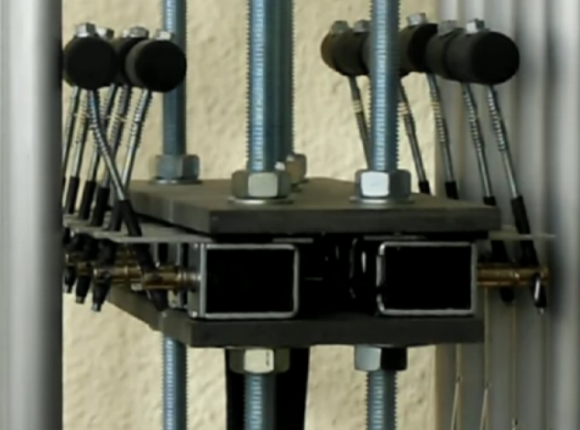
We’ve got to say it… these tubular bells sound awful! They don’t really have a tight pitch center so they sound really out of tune to us. But we think that’s the failing of the instrument itself and not the work which [Tolaemon] did to automate the instrument.
There are three main parts to his project. The first, which is shown above, adds a hammer for each bell. The hammers are hinged, with one side being pulled by a solenoid in order to strike the bell. The second part of the hack also uses solenoids, dampening the bell’s ability to ring by pressing a felt pad up against the bottom of the tube. The final portion of the project brings it all home by adding MIDI control to the hardware.
The clip after the break gives a good overview of the different features including some preprogrammed playback as well as direct control of the instrument using an electric keyboard. This reminds us of that scratch-built solenoid xylophone.
[Thanks Jordi]















The web page looked cool at first, but after scrolling down about halfway through the “washed out” B&W images, I was ready to call it quits…
I wonder if the way the tubes are mounted are causing the “off-key” sound? Are they mounted too rigidly? Do the felts suppress the vibrations before the sound envelope is fully formed? Are the tubes tuned for quarter tones instead of half tones? Perhaps some minor alterations could be made to the tubes to improve their tones…
Someone has an itchy “Sketch Filter” finger
http://www.youtube.com/watch?v=m60s70qX-xw
Those are most definitely out of tune. It may seem odd, but it seems idiophones like vibes/marimbas/chimes arent immune to losing tuning.
I worked at a school teaching winter drumline for a few years and we had a vibe that had it’s middle C drop by a quartertone over a period of about 2 weeks.
I’d be willing to bet he got the chimes secondhand and therefore are old like our vibes were.
EIther that, or he may be getting a perfect seal on the bottom of the chimes when he dampens. A tube with a closed end has a different fundimental frequency than does a tube with both ends open. It does eem like the tuning gets worse when he dampens…
Yes, it’s called ‘Tubular Bells’ but it uses a Glockenspiel, not a bell rack like this.
I find it more interesting that it was the first album ever released by Virgin.
Actually, I think that’s just how tubular bells sound. There’s a set on campus where I study and they play songs from time to time… it sounds just as bad. Same thing with any grandfather clock I’ve heard. I think it’s because the harmonics are different from any instrument we’re used to. A column of air or a vibrating string have fairly simple harmonics with the integer-fraction wavelengths, etc. It sounds natural–probably becasue we’re so used to it. Bells are different, I imagine. It would be interesting to look at the FFT of a note produced by these bells and analyze its harmonics and compare it with something like a xylophone or a guitar.
Incidentally, the incredibly high tension in piano strings give their harmonics a slight non-linearity which is part of what makes the piano have such a distinctive sound. I can’t say for sure, but I think that’s why it’s easier to play giant chords on an organ than on a piano. It’s all interesting stuff.
Yes, the combined tension of the strings on a piano is around 20 tons of force. (So I’ve heard)
Hell, an upright bass is said to have a few hundred pounds of force and it only has 4 strings under low tension.
Low is a relative term. I watched a string snap and take the bow with it before and I’ve heard horror stories of them making contact with an arm.
Anyone getting an exorcist vibe :D
Awesome project!
One: the strike spot is in a weird place, it’s usually at the top on the side.
Two: the dampers are aggressive, too quick a decay.
Three: the harmonics of the bells are mostly in the higher range of musical harmonics, like playing organ with no 8 foot stops and lots of partials like 1 3/5′ mixtures etc. Not that there is anything wrong with it. Musically you are supposed to fill in the missing fundamental with ground bass.
He should look at a set of Deagen chimes, one solenoid does it all for each note.
Damper is at the top also.
“ground bass”? The kind you get from a “Bass-o-Matic” [TM]? (old Saturday Night Live reference)
They sound like wind chimes and I just had a really weird thought. What if you had a set of wind chimes with a hammer mechanically connected to a pinwheel/blade that used that wind power to play a melody.Probably a huge waste of time but it would be pretty neat.
That’s what I was thinking. Most wind chimes aren’t tuned remotely close to what is necessary for an instrument. They may be assembled to produce a certain sound/chord, but they aren’t really meant for playing a song.
Still a really cool hack though.
Nobody has dared to describe this as a “tubular” hack?
Totally (tubular)!
The placement of the impact point and the rigidity of the support has a great influence on the mellowness of the sound. It will only get as good as the tube themselves but I look forward to hearing better results after some “tuning”. Great start and a lot of effort.